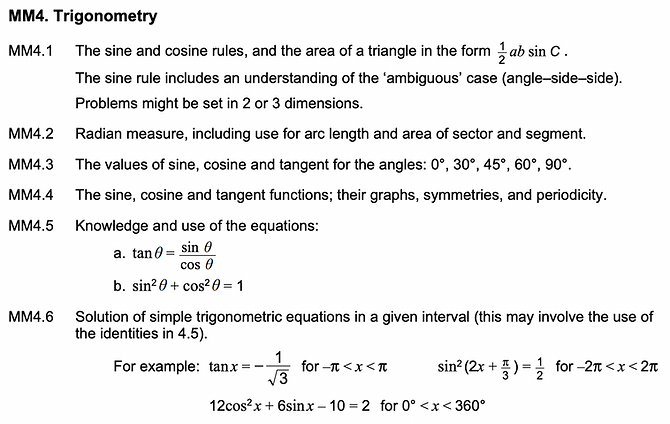TMUA Topic Menu
TMUA Topic 4. Trigonometry
Exam Techniques
Trigonometry is a significant part of the TMUA exam and questions come in many different styles. These can involve finding the solutions to trigonometric equations; manipulation using simple trigonometric identities; considering the shape of graphs of trigonometric functions; using your knowledge of the exact values of a variety of trigonometric functions or a combination of any of these techniques. Questions may also combine trigonometry with content from any other section of the specification, for example considering a quadratic equation given in terms of 'sin x'.
There may also be geometry questions involving 2-D or 3-D shapes, which could require use of the sine rule, or cosine rule, or consideration of the ambiguous case in triangles. You may need to calculate a variety of angles, lengths, or areas using trigonometry, including finding the shortest path around the exterior of a 3-D shape by considering the net of the shape.
The main difference from A Level is that you do not have a calculator to rely on, and so you must be able to recall the exact values of sine, cosine, and tangent for the common angles given in the specification, and be able to extend these to calculate other angles. You must be able to work in degrees and radians, or at least be able to convert between these quickly. You must also be able to derive all the possible solutions for a trigonometric equation from the principal value using the shape and periodicity of the relevant graph (or CAST diagram if you must - although I am not a fan of this method!).
You may need to identify the number of solutions to an equation by solving it directly, or by sketching the graphs of separate functions and looking for the number of points of intersection. You may need to extend this method further to find regions where one function is greater than another. You might need to identify where certain functions are positive or negative, and therefore deduce where products or quotients of these functions are positive or negative. In all these questions it is important that you are confident in using transformations of graphs to understand the shape of the respective graphs.
You are not required to differentiate or integrate trigonometric functions in this exam, but you may need to consider transformations of the basic graphs, in order to identify the turning points of a more complex graph, or to compare the magnitude of areas under different curves.
Common questions require you find the maximum or minimum of a trigonometric expression, and depending on the type of expression, you may need to consider a series of transformations, or spot a disguised quadratic, and then deduce what effect this has on your expression. For example a quadratic in 'sin x' will only have a domain -1 ≤ sin x ≤ 1 and therefore you only need to consider this section of the quadratic graph.
Official Specification 2025
